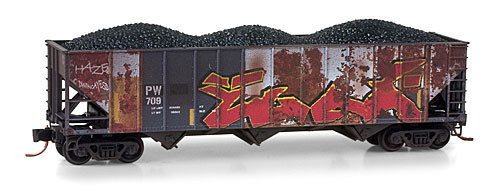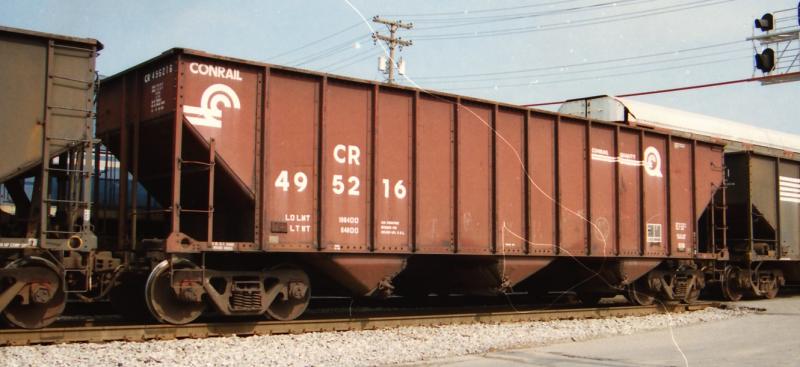Model Information: Micro-Trains launched this body style in April of 2000. Since then it has appeared in over 100 different regular releases (including multi-packs) as well as special runs. It features truck-mount couplers on barber trucks. These cars model prototypes that were built in in the late 1970s and 1980s.
Prototype History: The 1960s brought about a growth in car size (and capacity). Railroads that transported coal moved away from the older 2-bay 55-ton USRA standard to newer 90- and 100-ton three bay hoppers. On the WM, the first 90 ton cars were purchased for stone service to Sparrows Point around 1963. These cars were effective and long-lived. Many railroads swapped out the trucks on these cars to increase the capacity to 100 tons. Many companies produced these, including Pullman, Bethlehem, Evans, Greenville, Trinity and Ortner. Details, of course, vary from manufacturer to manufacturer, but typically they were rib-sided. As of 2007, the NS still had lots of 90 ton hoppers in coal service.
Road Name History:  The Providence and Worcester Railroad (reporting mark PW) (NASDAQ: PWX) is a Class II railroad in the United States. The railroad connects from Gardner in central Massachusetts, south through its namesake cities of Worcester and Providence, Rhode Island, and west from Rhode Island through Connecticut and into New York City. The railroad's connection between New Haven, Connecticut and New York City and onto Long Island is via trackage rights over the Hell Gate Bridge.
The Providence and Worcester Railroad (reporting mark PW) (NASDAQ: PWX) is a Class II railroad in the United States. The railroad connects from Gardner in central Massachusetts, south through its namesake cities of Worcester and Providence, Rhode Island, and west from Rhode Island through Connecticut and into New York City. The railroad's connection between New Haven, Connecticut and New York City and onto Long Island is via trackage rights over the Hell Gate Bridge.
The P&W was incorporated in Massachusetts as the Providence and Worcester Railway on March 12, 1844, and as the Providence and Worcester Railroad in Rhode Island in May 1844. The two companies were merged November 25, 1845 as the Providence and Worcester Railroad. The company bought the Blackstone Canal, also running between Providence and Worcester, and began construction, partly on its banks, in 1845. The line opened in two sections, the part south of Millville on September 27, 1847, and the rest on October 20. The line from Providence to Central Falls was shared with the Boston and Providence Railroad, which at the same time built a connection from its old line (ending in East Providence) over to the P&W.
On July 1, 1892, the New York, New Haven and Hartford Railroad leased the P&W for 99 years. The New Haven merged into Penn Central on January 1, 1969. On April 6, 1970, the P&W announced its intention to separate from the merger. After a legal battle, the Interstate Commerce Commission approved the request on August 25, 1972, and, on November 2, Penn Central signed the agreement, effective December 30. The P&W cancelled the lease on February 3, 1973. Since then, the P&W has taken over many other lines from the former Penn Central in addition to several from the Boston and Maine Railroad. On March 17, 2013, a freight derailed in New Haven, Connecticut, blocking Amtrak's Northeast Corridor.

The P&W was incorporated in Massachusetts as the Providence and Worcester Railway on March 12, 1844, and as the Providence and Worcester Railroad in Rhode Island in May 1844. The two companies were merged November 25, 1845 as the Providence and Worcester Railroad. The company bought the Blackstone Canal, also running between Providence and Worcester, and began construction, partly on its banks, in 1845. The line opened in two sections, the part south of Millville on September 27, 1847, and the rest on October 20. The line from Providence to Central Falls was shared with the Boston and Providence Railroad, which at the same time built a connection from its old line (ending in East Providence) over to the P&W.
On July 1, 1892, the New York, New Haven and Hartford Railroad leased the P&W for 99 years. The New Haven merged into Penn Central on January 1, 1969. On April 6, 1970, the P&W announced its intention to separate from the merger. After a legal battle, the Interstate Commerce Commission approved the request on August 25, 1972, and, on November 2, Penn Central signed the agreement, effective December 30. The P&W cancelled the lease on February 3, 1973. Since then, the P&W has taken over many other lines from the former Penn Central in addition to several from the Boston and Maine Railroad. On March 17, 2013, a freight derailed in New Haven, Connecticut, blocking Amtrak's Northeast Corridor.
Brand/Importer Information: Micro-Trains is the brand name used by both Kadee Quality Products and Micro-Trains Line. For a history of the relationship between the brand and the two companies, please consult our Micro-Trains Collector's Guide.
Manufacturer Information:  Micro-Trains Line split off from Kadee Quality Products in 1990. Kadee Quality Products originally got involved in N-Scale by producing a scaled-down version of their successful HO Magne-Matic knuckle coupler system. This coupler was superior to the ubiquitous 'Rapido' style coupler due to two primary factors: superior realistic appearance and the ability to automatically uncouple when stopped over a magnet embedded in a section of track. The success of these couplers in N-Scale quickly translated to the production of trucks, wheels and in 1972 a release of ready-to-run box cars.
Micro-Trains Line split off from Kadee Quality Products in 1990. Kadee Quality Products originally got involved in N-Scale by producing a scaled-down version of their successful HO Magne-Matic knuckle coupler system. This coupler was superior to the ubiquitous 'Rapido' style coupler due to two primary factors: superior realistic appearance and the ability to automatically uncouple when stopped over a magnet embedded in a section of track. The success of these couplers in N-Scale quickly translated to the production of trucks, wheels and in 1972 a release of ready-to-run box cars.
Micro-Trains Line Co. split off from Kadee in 1990 to form a completely independent company. For this reason, products from this company can appear with labels from both enterprises. Due to the nature of production idiosyncrasies and various random factors, the rolling stock from Micro-Trains can have all sorts of interesting variations in both their packaging as well as the products themselves. When acquiring an MTL product it is very important to understand these important production variations that can greatly enhance (or decrease) the value of your purchase.
Please consult our Micro-Trains Collector's Guide

Micro-Trains Line Co. split off from Kadee in 1990 to form a completely independent company. For this reason, products from this company can appear with labels from both enterprises. Due to the nature of production idiosyncrasies and various random factors, the rolling stock from Micro-Trains can have all sorts of interesting variations in both their packaging as well as the products themselves. When acquiring an MTL product it is very important to understand these important production variations that can greatly enhance (or decrease) the value of your purchase.
Please consult our Micro-Trains Collector's Guide
Item created by: gdm on 2016-02-19 18:02:09. Last edited by gdm on 2020-05-29 13:57:03
If you see errors or missing data in this entry, please feel free to log in and edit it. Anyone with a Gmail account can log in instantly.
If you see errors or missing data in this entry, please feel free to log in and edit it. Anyone with a Gmail account can log in instantly.









